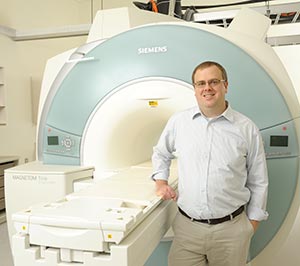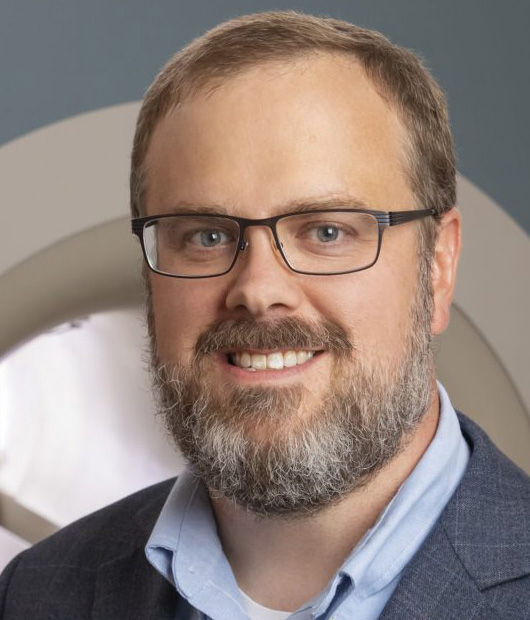The Biomedical Imaging Center (BIC) has a new capability that will make research easier and more efficient for BIC users. BIC is a shared resource facility at the Beckman Institute that provides facilities, equipment, and training for research on magnetic resonance imaging (MRI), spectroscopy, ultrasound, near infrared optical imaging, animal bioluminescence and fluorescence imaging along with animal PET, SPECT, and CT.
“Once image data is collected, we need to analyze it and do something with it. It turns out that step can be as important as the first step. We get the best technology, we set it up right, and we perform it correctly. Now, we have to analyze it with the best tools too,” said Brad Sutton, BIC’s technical director.
In order to analyze and share large data sets, including many images, more effectively, Sutton and Nate Wetter, a former master’s student in bioengineering, proposed a shared platform that would enable a user to launch a large number of virtual computers, configured with the appropriate software specifically for that user’s analysis purposes. Wetter constructed and configured BIC’s new tool, the Biomedical Imaging Center Neuroimaging Computing Cloud (BICNICC).
This new resource contains 60 cores with 18 gigabytes of RAM each, meaning 60 subjects can be analyzed at a time across the 60 computers. Sutton explained that this additional tool for the facility will improve the experience for researchers.
“I use the cloud computing to expedite the processing of my data. We have some large projects right now where many data sets come through. When I was doing it on a desktop, each data set was taking one to two months for general processing. Now, I can get 200 people processed in three days.”--Hillary Schwarb, BICNICC user
Sutton hopes the BICNICC can accommodate Beckman’s variety of users, across ranges of scale and expertise. Some users know exactly what parameters and software they want to use in the scanner, while some do not fully understand how to process the data or use the technology. BIC’s new system allows inexperienced users to utilize pre-existing pipelines and experienced users to utilize their own desired processes while scaling for large data sets.
The BICNICC also increases stability in research. While many researchers face the issue of software updates altering processing and data analysis, the cloud prevents those issues from occurring and allows reproducible research.

“We can provide an environment that has specific versions of all the software already installed and working together, and then we can make that software available five years from now,” said Sutton. “For example, if you have an R01 grant for five years, the data you got at the beginning has initial promising results. You can still run the same software package at the end and run the exact same analysis. You can feel comfortable that the software hasn’t changed during the course of the project.”
In addition to stability, the BICNICC also makes research involving images from the facility a lot more efficient.
“Without the cloud, it takes months. With the cloud, it takes days,” said Sutton.
Hillary Schwarb, a postdoctoral researcher, works on the INSIGHT project, a multidisciplinary study based at the Beckman Institute to determine what kind of training best improves adaptive reasoning and fluid intelligence. Schwarb utilized BICNICC for three months in order to process a large amount of data and methodologies. Schwarb’s data set includes 450 participants with approximately 1200 raw image files, creating a little over a gigabyte per each participant.
“I use the cloud computing to expedite the processing of my data,” said Schwarb. “We have some large projects right now where many data sets come through. When I was doing it on a desktop, each data set was taking one to two months for general processing. Now, I can get 200 people processed in three days.”
She believes that parallelization within the computational cloud increases the speed.
“It’s freed up my personal desktop so I can conduct other work while the information is processed, in a time-efficient way. The cloud allows me to check things regularly and fix issues as they’re happening. I know I can get complacent when studies run for a month at a time, but when it’s this quick, I check it every few hours,” said Schwarb.
One main benefit is the opportunity to share research between disciplines and projects.
“This is a template for the way things should be done in a shared facility like this, where lots of data is generated,” said Sutton. “Hopefully, this becomes an example of what can be accomplished when you share a computational resource, and, hopefully, it will bring all biomedical imaging users at Illinois together. BIC can provide an environment where labs can not only acquire data, but also collaborate.”
A number of researchers have already utilized the new service, ranging from those in neuroscience, psychology, biomedical engineering, and more.
“The comment usually is ‘I couldn’t have done this in my own lab except with lots of time’ or ‘There’s no way we would’ve gotten this result in this amount of time with our own resources,’ ” said Sutton.
Both current users and Sutton believe the new addition to BIC is a great resource for both Beckman research and the research community at large. He hopes to see an increased interest in the system and more researchers participating.
“Having a shared resource is going to bring the community together and make it stronger. It will show neuroimaging at Illinois has consistency and stability. I hope we’ll be able to pull a lot of institutional knowledge together,” said Sutton.
For more information on BICNICC regarding research, please contact Sutton at bsutton@illinois.edu.
